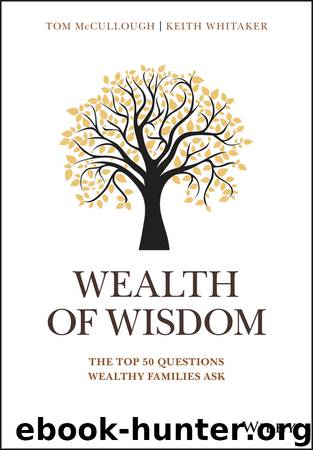Wealth of Wisdom by Tom McCullough & Keith Whitaker

Author:Tom McCullough & Keith Whitaker
Language: eng
Format: epub
ISBN: 9781119331520
Publisher: Wiley
Published: 2018-12-03T00:00:00+00:00
Figure 27.1 The Seniors’ “Pyramid” View of the Family
But in most cases that is not how the younger generations picture the family. Each younger generation, as they move into adulthood, begins to create a pyramid of their own (at least in Western cultures). See Figure 27.2.
Figure 27.2 The Complex Family Network
Education, work, finding a partner, and having children, enact the “centrifugal” force toward differentiation, as offspring grow up and create a “self” as a more independent adult. Some portion of their new pyramid will be connected to the original structure (the thicker arrows) – more if they work in the company, or live near their parents and foster close ties between grandparents and grandchildren; less if they move away, geographically or psychologically, and have little to do with the operations and financial benefits of enterprise ownership. But in all cases, the link to the home pyramid is only part of their lives (especially since their spouse is connected to her or his own “pyramid of origin” as well, closely or loosely). Very importantly, the new sub‐families are also connected to each other directly, not through their parents, with varying degrees of closeness (the thinner arrows). As families move through the third and later generations, the number of sibling and cousin pyramids can get very large, working outward in concentric circles of engagement, as the thinner arrows come to greatly outnumber the thicker ones.
The most important consequence of this natural development is that the governing family is no longer a unified pyramid, but a network of units, constantly adjusting their links in the overall system. The idea that “this is who we are and this is how we do things” gives way to a woven array of unit‐to‐unit relationships – some tight and close, some stretched and weak, some units closely embedded in connection with many others, and some only attached to one or two, with little connection to the core. The emotional tone of individual relationships can range from constant active hostility to indifference to lifetime intimacy, each link contributing to the pattern of interdependence and distance that is the unique “footprint” of every particular family network. Furthermore, that footprint evolves year by year, as individuals age and change, and their personal pyramids add and lose members. The fundamental perspective that has meaning for governance is that, across time and change, the family is defined by the network of these relationships, not by the rules of an “in or out” boundary enclosing a homogeneous crowd.
This is not a revolutionary concept. All family theorists reflect on the inevitable increase in family diversity over time. Nevertheless, family governance design often rests in the hands of senior owners who may try to ignore the implications of generational complexity. Legitimately worried about disintegration, they focus too much on “keeping the family together” and not enough on recognizing and celebrating the evolution of the family in new directions.
Parents who try to defend the unitary pyramid may exaggerate the threat to the family’s common financial interests
Download
This site does not store any files on its server. We only index and link to content provided by other sites. Please contact the content providers to delete copyright contents if any and email us, we'll remove relevant links or contents immediately.
The Black Swan by Nassim Nicholas Taleb(6763)
Bad Blood by John Carreyrou(6274)
Pioneering Portfolio Management by David F. Swensen(6078)
Millionaire: The Philanderer, Gambler, and Duelist Who Invented Modern Finance by Janet Gleeson(4093)
Skin in the Game by Nassim Nicholas Taleb(3965)
The Money Culture by Michael Lewis(3846)
Bullshit Jobs by David Graeber(3828)
Skin in the Game: Hidden Asymmetries in Daily Life by Nassim Nicholas Taleb(3722)
The Wisdom of Finance by Mihir Desai(3523)
Blockchain Basics by Daniel Drescher(3329)
Liar's Poker by Michael Lewis(3220)
The Intelligent Investor by Benjamin Graham Jason Zweig(2930)
Hands-On Machine Learning for Algorithmic Trading by Stefan Jansen(2925)
Mastering Bitcoin: Programming the Open Blockchain by Andreas M. Antonopoulos(2891)
Fooled by Randomness: The Hidden Role of Chance in Life and in the Markets by Nassim Nicholas Taleb(2860)
Investing For Dummies by Eric Tyson(2793)
The Power of Broke by Daymond John(2772)
Market Wizards by Jack D. Schwager(2538)
Zero Hour by Harry S. Dent Jr. & Andrew Pancholi(2531)
